Special Report
The Fastest Growing (and Shrinking) State Economies

Published:
Last Updated:

After years of rapid post-recession economic growth, the U.S. economy has begun to cool off. The nation’s GDP rose by 1.5% in 2016, slower than the 2.6% increase in 2015 and 2.2% increase in 2014.
Many of the economic trends notable throughout the nation since the Great Recession have reversed in recent years. While growth in the U.S. mining sector outpaced nearly every other industry in the three years ending 2014, mining activity declined in 2016, detracting from GDP growth more than any other sector.
Meanwhile, the information services sector led the country’s GDP growth after relatively lackluster growth in 2011, 2012, and 2014. Most states with large information sectors experienced positive economic growth in 2016, while states that are largely dependent on the mining sector did not.
To determine the states with the fastest growing and fastest shrinking economies, 24/7 Wall St. reviewed 2016 real GDP growth rates for all 50 states with data from the Bureau of Economic Analysis. While GDP rose more than 2% in 11 states nationwide in 2016, the economy of seven states contracted.
Click here to see the states with the fastest growing economies.
Click here to see the states with the fastest shrinking economies.
Click here to see the detailed findings and methodology.
These are the fastest growing (and shrinking) states economies.
Shrinking Economies:

7. New Mexico
>2016 GDP change: -0.5%
>2016 GDP: $86.0 billion (14th smallest)
>Largest industry decline: Mining
>1-yr. population change: 0%
New Mexico was one of seven state economies that contracted in size over the past year. While the national GDP grew by 1.5%, New Mexico’s GDP contracted by 0.5%. Like the rest of the country, New Mexico’s economic decline was largely due to a shrinking mining industry. Mining is the third largest industry in New Mexico, and the industry-wide output fell from $10.8 billion in 2015 to $9.6 billion in 2016. While New Mexico’s crude oil production actually increased by nearly 560,000 barrels last year, the average domestic purchase price fell from $44.39 per barrel to $38.29.
While the U.S. unemployment rate fell from 5.3% in 2015 to 4.9% in 2016, New Mexico’s jobless rate rose from 6.6% to 6.7%, the highest unemployment rate of any state.
[in-text-ad]

6. Louisiana
>2016 GDP change: -0.6%
>2016 GDP: $205.6 billion (25th largest)
>Largest industry decline: Mining
>1-yr. population change: 0.3% (20th smallest growth)
Louisiana’s mining and real estate industries were largely behind the state’s negative economic growth rate. The state’s crude oil production, which has been in a steady decline since peaking in 1970, fell by nearly 6 million barrels from 2015 to 2016. The domestic price of crude oil fell slightly last year, and fell more in Louisiana than in any state other than Mississippi and California.
After years of rising home prices and suburban expansion, Louisiana also had the largest decline in real estate activity of any state in 2016. The number of single family homes sold in the New Orleans metro area fell by roughly 35% between 2015 and 2016, and the increase in home prices in the city has begun to slow down. The industry’s statewide GDP fell by $1 billion, the second most of any sector in Louisiana.

5. West Virginia
>2016 GDP change: -0.9%
>2016 GDP: $66.5 billion (11th smallest)
>Largest industry decline: Construction
>1-yr. population change: -0.5% (the largest decline)
The total value of all goods and services produced in West Virginia fell by 0.9% in 2016, the fifth largest economic contraction of any state. The state’s construction, mining, and wholesale trade sectors led the state’s economic decline.
West Virginia’s economy has also been struggling due to the state’s rapid population loss. Not only did West Virginia have the largest population decline due to natural causes, but the state had one of the largest outbound migrations in the country. The number of state residents fell by 0.5% in 2016, the largest decline of any state. While the outbound migration likely included some jobless workers, which may have helped West Virginia’s unemployment rate to fall from 6.8% in 2015 to 6.0% in 2016, the state’s jobless rate remains the fourth highest in the country.
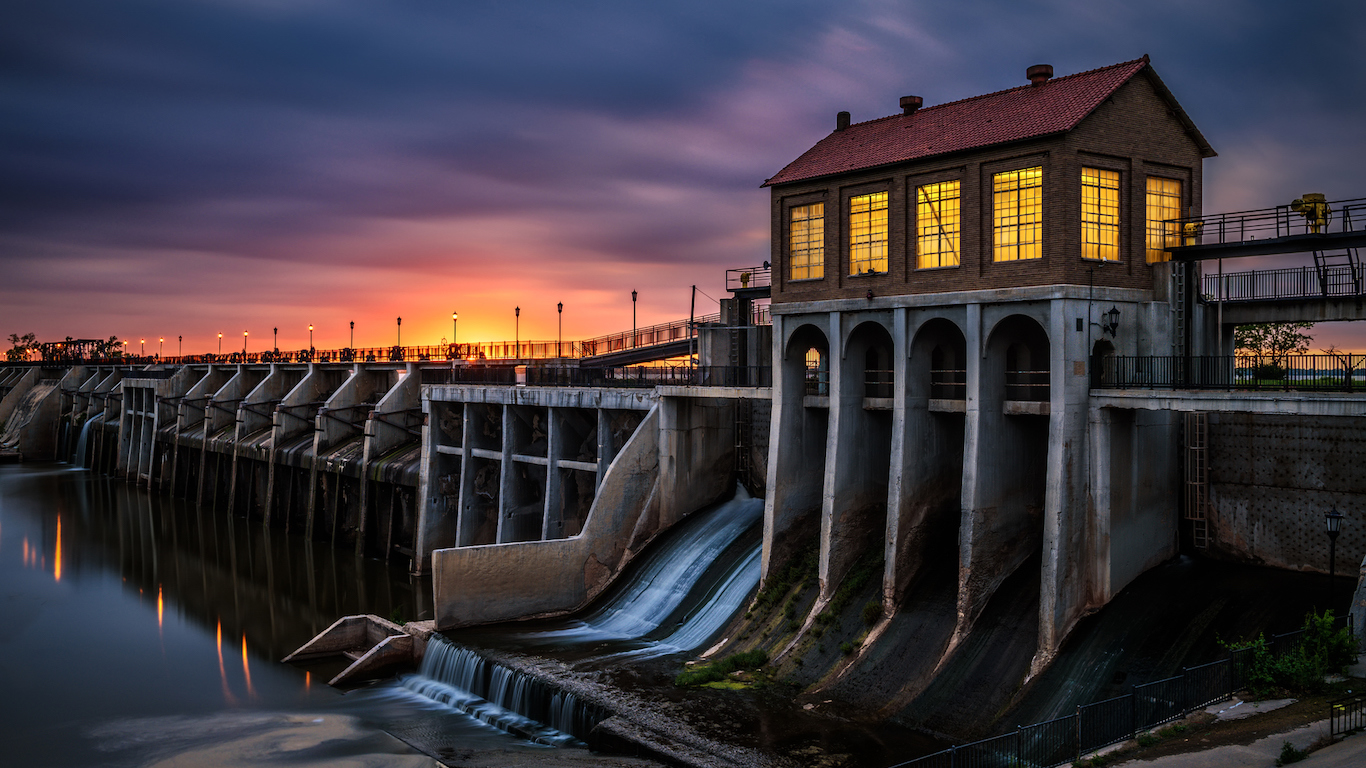
4. Oklahoma
>2016 GDP change: -2.3%
>2016 GDP: $175.1 billion (23rd smallest)
>Largest industry decline: Mining
>1-yr. population change: 0.4% (22nd largest growth)
Oklahoma is one of 41 states where economic activity in the mining sector declined in 2016. The state produced 4.1 million barrels less in 2016 compared to 2015, and the price of the commodity nationwide fell from $44.39 per barrel to $38.29 per barrel, its lowest point since 2004. Mining is the largest industry in Oklahoma, contributing more to the state economy than in any state other than Texas.
The downturn in the state’s oil and gas sector has also led to declines in its manufacturing industry. Oklahoma’s manufacturing industry is largely concentrated in metals and machinery factories, many of which are used to produce goods for natural resource extraction. As Oklahoma’s mining industry contracted by 14.0% in 2016, durable goods manufacturing activity in the state fell by 9.7%, the fourth largest such decline nationwide.
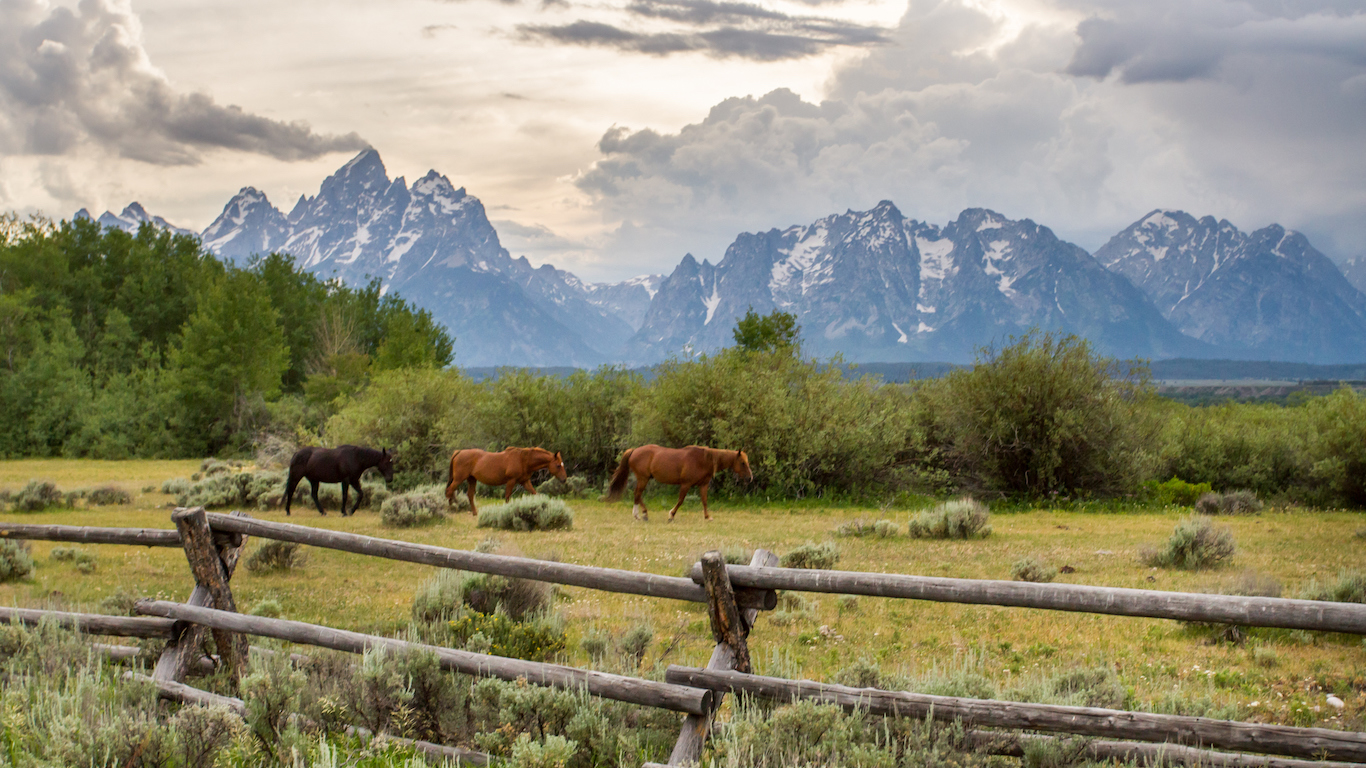
3. Wyoming
>2016 GDP change: -3.6%
>2016 GDP: $34.4 billion (2nd smallest)
>Largest industry decline: Mining
>1-yr. population change: -0.2% (5th largest decline)
More dependent on mining than any other state, Wyoming’s economy has struggled as energy prices have declined in recent years. Wyoming lacks any major metropolitan areas, which is where most of the U.S. economic growth has been concentrated in recent years. Mining, which accounts for about one in every four dollars generated in the state, contributed to the largest decline in Wyoming GDP of any sector in 2016. Declines in the mining industry accounted for 1.7 percentage points, or roughly half, of the state’s 3.6% GDP contraction. Crude oil production in Wyoming fell from 86.5 million barrels in 2015 to 72.3 million in 2016, as the price of the commodity nationwide fell from $44.39 to $38.29 per barrel.
[in-text-ad]
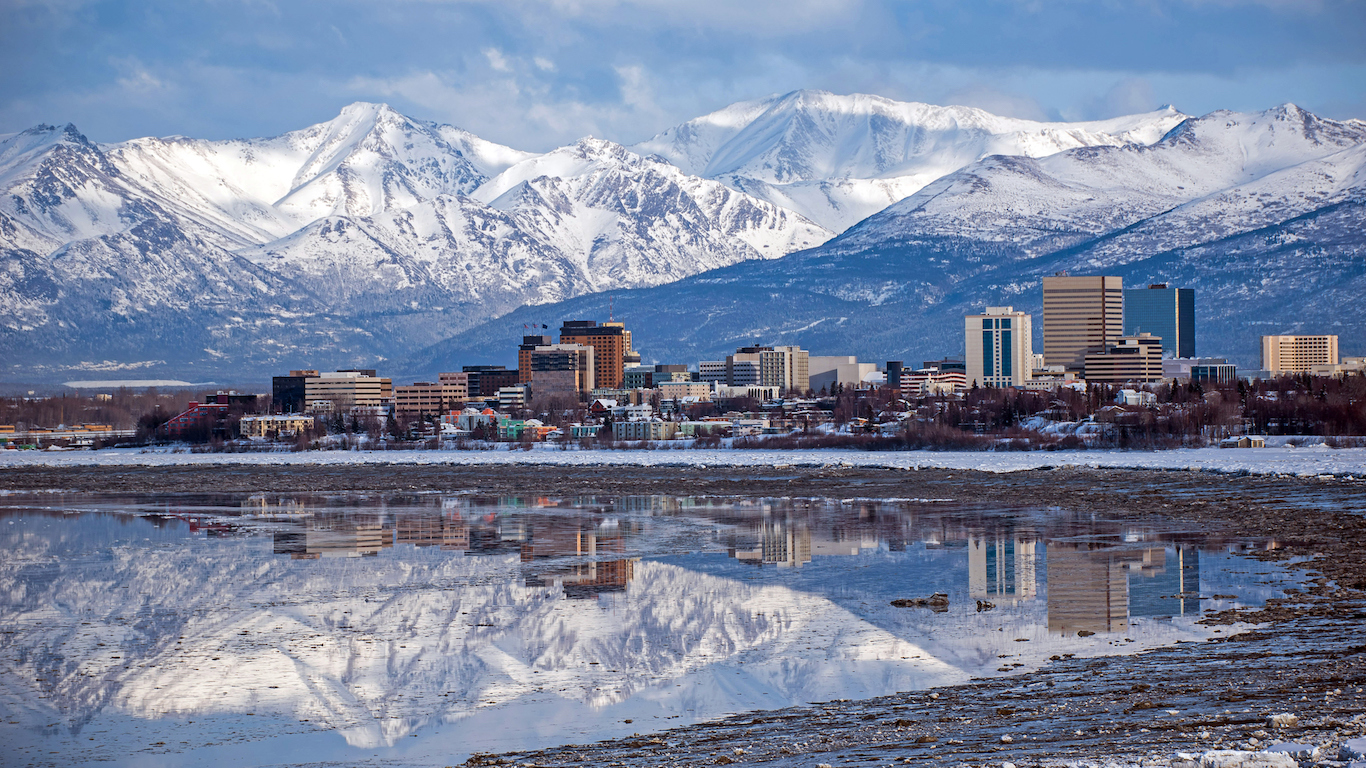
2. Alaska
>2016 GDP change: -5.0%
>2016 GDP: $47.5 billion (5th smallest)
>Largest industry decline: Mining
>1-yr. population change: 0.6% (20th largest growth)
Alaska is more dependent on the mining industry than any state other than Wyoming. The mining industry accounts for 21% of the state’s GDP and has historically accounted for 90% of the Alaskan government’s general fund budget. Alaska’s mining GDP fell from $12.6 billion in 2015 to $10.1 billion in 2016, the largest decline of any sector in the state.
While Alaska’s population grew overall due to high birth and low death rates, the state had one of the largest outbound migrations in the country. Despite a net total of 2,200 members of the labor force leaving Alaska, likely due to to a tough job market, the state’s unemployment rate rose from 6.4% to 6.6% — today the second highest nationwide. Alaska is one of only three states where the number of unemployed workers increased even as the size of the total labor force declined.
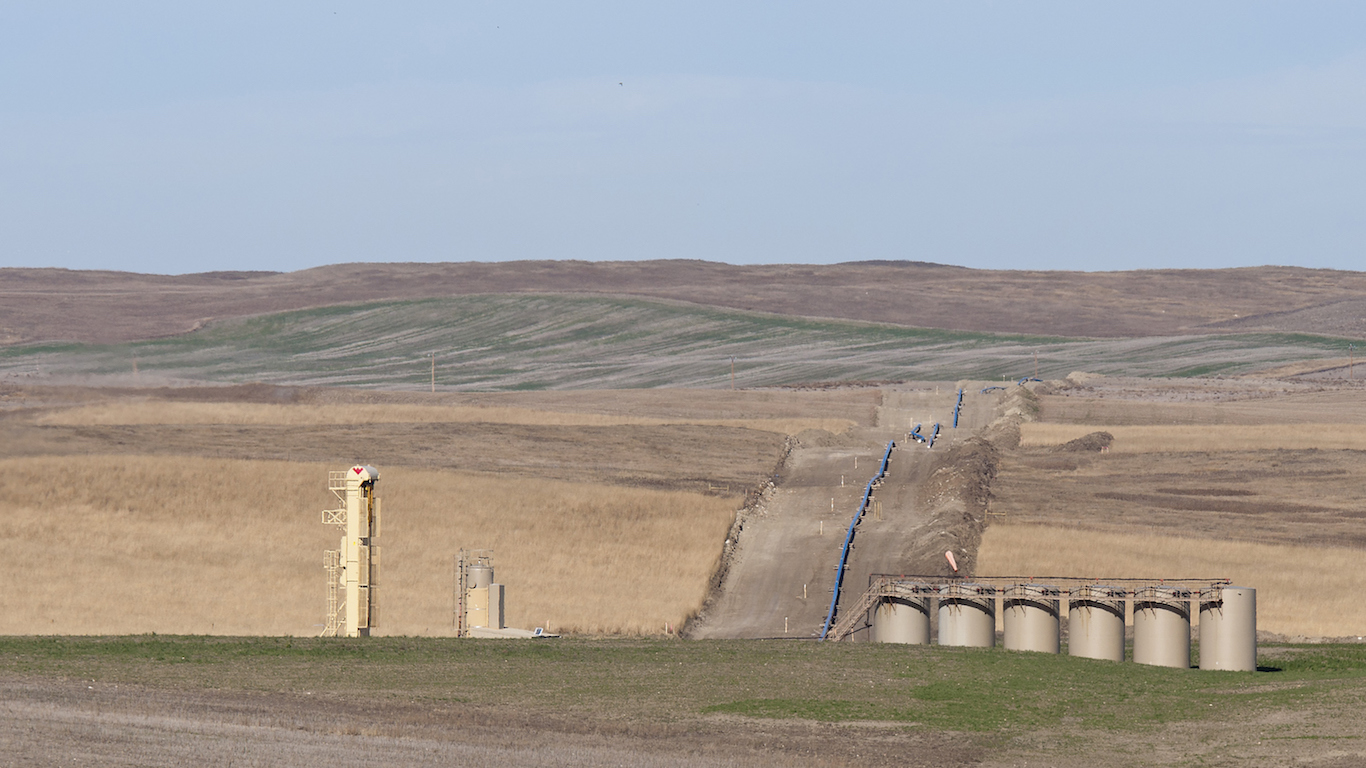
1. North Dakota
>2016 GDP change: -6.5%
>2016 GDP: $47.6 billion (6th smallest)
>Largest industry decline: Mining
>1-yr. population change: 0.1% (15th smallest growth)
For years, North Dakota’s economy grew at a nation-leading pace due to the discovery of the Parshall Oil Field in the Bakken Formation in 2006. Crude oil production increased more than tenfold over the following decade, from 35.7 million barrels in 2005 to a 429.4 million barrel peak output in 2015. The price of oil began to slide in 2014, however, slowing the state’s oil boom and eventually reversing the direction of North Dakota’s economic growth. While the U.S. economy expanded 1.5% in 2016, North Dakota’s economy contracted by 6.5%. The mining sector was the largest drag on the state’s economy. Industries related to oil production, such as transportation, wholesale trade, and construction, also contributed to the state’s economic decline.
Growing Economies:

11. South Carolina
>2016 GDP growth: 2.1%
>2016 GDP: $183.9 billion (25th smallest)
>Largest industry contribution: Construction
>1-yr. population change: 1.4% (10th largest growth)
Some of the largest areas of economic growth in the U.S. are in the Southeast, where waves of Americans are relocating for low cost of living, job opportunities, and warm weather. Largely due to inbound migration, South Carolina’s population grew by 1.4% between 2015 and 2016, one of the largest population increases of any state. The influx of new residents led to increased economic activity.
South Carolina’s GDP expanded 2.1% last year, and the unemployment rate fell from 6.0% in 2015 to 4.8% in 2016. The construction sector contributed the most to economic growth, in part due to rebuilding projects in the aftermath of the state’s historic 2015 flood. The next largest contributors were the professional services and retail trade sectors.
[in-text-ad]

10. Arizona
>2016 GDP growth: 2.1%
>2016 GDP: $267.5 billion (21st largest)
>Largest industry contribution: Health care and social assistance
>1-yr. population change: 1.7% (8th largest growth)
A popular retirement destination, Arizona has one of the oldest populations of any state. As new residents flocked to the state, the share of Arizonans 65 years and older rose from 13.8% in 2010 to 16.4% in 2015 — today the ninth largest share in the country. And as the population aged, demand for health care services increased. The GDP for the health care and social assistance sector increased by more than $1 billion in Arizona in 2016, the most of any state industry.
The real estate and information sectors also contributed to Arizona’s economic growth. Overall, the state’s GDP rose by 2.1% in 2016, far more than the 1.5% growth nationwide.

9. Hawaii
>2016 GDP growth: 2.1%
>2016 GDP: $73.3 billion (13th smallest)
>Largest industry contribution: Construction
>1-yr. population change: 0.2% (19th smallest growth)
Hawaii has experienced a massive surge in tourism in recent years. A record 8.9 million people visited the state in 2016, with tourists spending an average of $194 each on a daily basis. The increase in tourism partially contributed to increased activity in the construction, real estate, and transportation sectors — the three largest growth areas in the Hawaiian economy.
Hawaii’s economic growth was also facilitated by a healthy job market. As the state’s labor force added 10,500 workers between 2015 and 2016, the unemployment rate fell from 3.6% to 3.0% — today the third lowest of any state. Over the same period, GDP per capita rose by 1.9% to $51,277, a sharper spike than in any state other than New York and Massachusetts.

8. Nevada
>2016 GDP growth: 2.4%
>2016 GDP: $128.8 billion (18th smallest)
>Largest industry contribution: Arts, entertainment, and recreation
>1-yr. population change: 2.0% (2nd largest growth)
Inbound migration to Nevada last year helped spur economic growth and reduce unemployment throughout the state. Nevada’s population grew by 2.0% in 2016, more than any state other than Utah. Unemployment fell from 6.8% in 2015 to 5.7% in 2016, and the economy grew by 2.4% — far more than the 1.5% national GDP growth.
Nevada is the only state where the arts, entertainment, and recreation sector led economic growth last year. While the sector accounts for just 3.1% of the state’s total GDP, it accounted for $256 million, or 20%, of the state’s total GDP growth of $3 billion. Much of the sector’s growth occurred in the Las Vegas metro area, where the hotel and casino industries have experienced an increase in tourism and construction activity. The construction sector was the second largest contributor to Nevada’s GDP growth in 2016.

7. California
>2016 GDP growth: 2.9%
>2016 GDP: $2.30 trillion (the largest)
>Largest industry contribution: Information
>1-yr. population change: 0.7% (19th largest growth)
Like the U.S. as a whole, the information services sector contributed the most to California’s GDP growth over the past year. Led by Silicon Valley and other tech clusters throughout the state, California’s information sector expanded by $17.9 billion in 2016, accounting for nearly 33% of the sector’s overall growth nationwide.
Unlike most states on this list, California’s GDP growth was not the result of population growth due to domestic migration. The state’s population growth was largely due to a high birth rate and only increased by 0.1% from net migration. California’s economic expansion, which was largely the result of rising labor productivity and a healthy job market, has led to substantial increase in individual wealth. The state’s GDP per capita rose by 2.3% in 2016, the most of any state other than New Hampshire.
[in-text-ad]

6. New Hampshire
>2016 GDP growth: 3.0%
>2016 GDP: $69.1 billion (12th smallest)
>Largest industry contribution: Finance and insurance
>1-yr. population change: 0.4% (25th smallest growth)
New Hampshire is the only state in New England where GDP grew more than 2.0% in 2016. The state’s economy expanded rapidly despite relatively lackluster population growth. While the state’s economy grew by 3.0%, twice the national rate, the number of state residents grew by just 0.4%, about half the U.S. figure.
The two components of GDP growth are population change and labor productivity. In New Hampshire, economic growth was largely the result of increased productivity, which led to a substantial increase in individual wealth. The New Hampshire GDP per capita rose by 2.7% in 2016 to $51,794, the largest increase of any state. Growth was led by the finance and insurance sector, followed by health care and professional services.
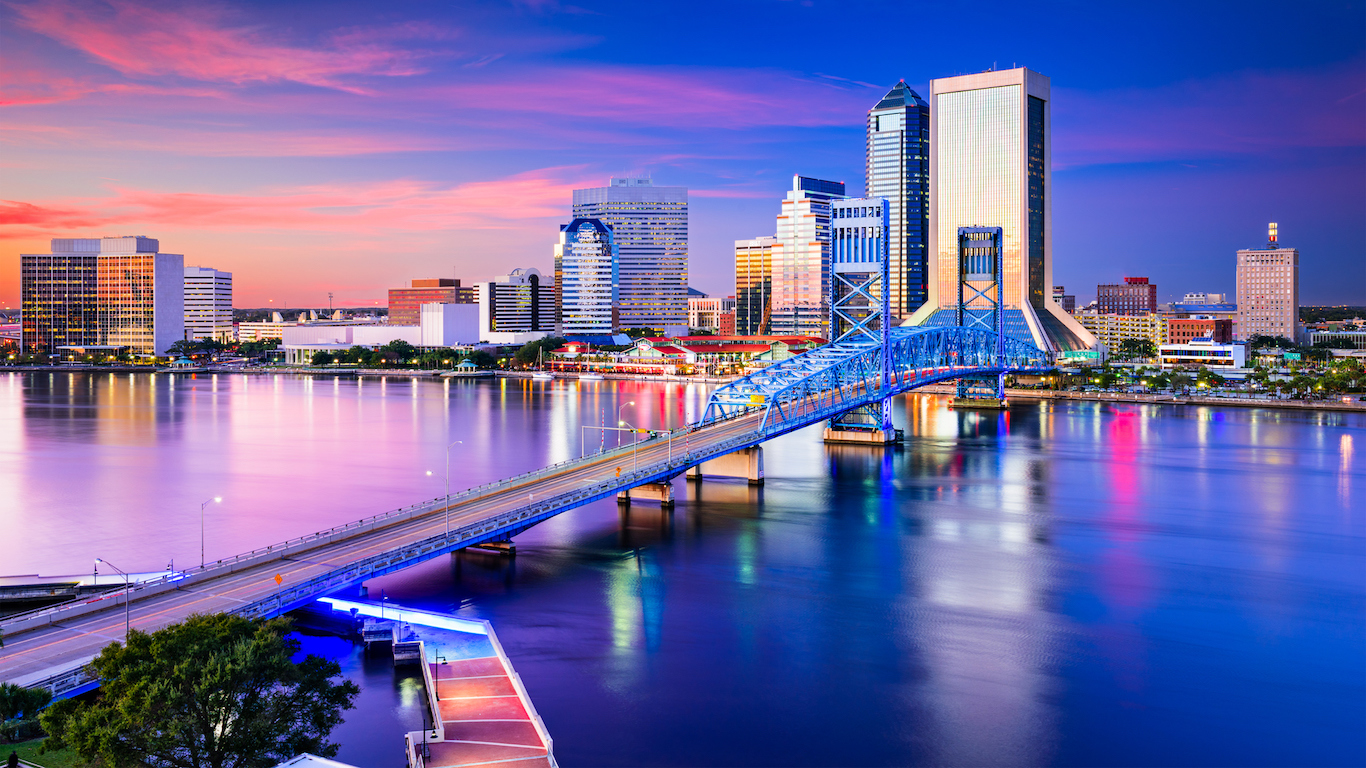
5. Florida
>2016 GDP growth: 3.0%
>2016 GDP: $815.1 billion (4th largest)
>Largest industry contribution: Professional, scientific, and technical services
>1-yr. population change: 1.8% (4th largest growth)
Florida’s economy grew at a 3.0% pace in 2016, twice the 1.5% national GDP growth rate. Economic growth was led by the professional, scientific, and technical services sector, followed by construction and information services. Over the same period, the share of unemployed workers in the Florida labor force fell from 5.4% to 4.9%.
The state’s economic expansion was largely due to rapid population growth. Florida surpassed New York as the third most populous U.S. state in 2014 and continues to grow at a nation-leading pace. Florida’s population grew by 1.6% due to net migration last year — the most of any state — and by 1.8% overall.

4. Georgia
>2016 GDP growth: 3.0%
>2016 GDP: $461.1 billion (9th largest)
>Largest industry contribution: Information
>1-yr. population change: 1.1% (12th largest growth)
Georgia is one of many states in the southeast where hundreds of thousands of Americans are relocating for the low cost of living and favorable job market. The influx of new residents also spurred economic growth in the state. Georgia’s population increased by 1.1% between 2015 and 2016, faster than the 0.7% national figure. The state’s GDP rose by 3.0% in 2016, and unemployment fell from 6.0% to 5.4%.
The influx of new residents has likely yielded increased construction and real estate activity. Both sectors grew by $1.5 billion in 2016, more than any industry in Georgia other than information services. The information services sector expanded by $3.4 billion, approximately 25% of the state’s overall GDP increase of $13.2 billion over the past year.
[in-text-ad]
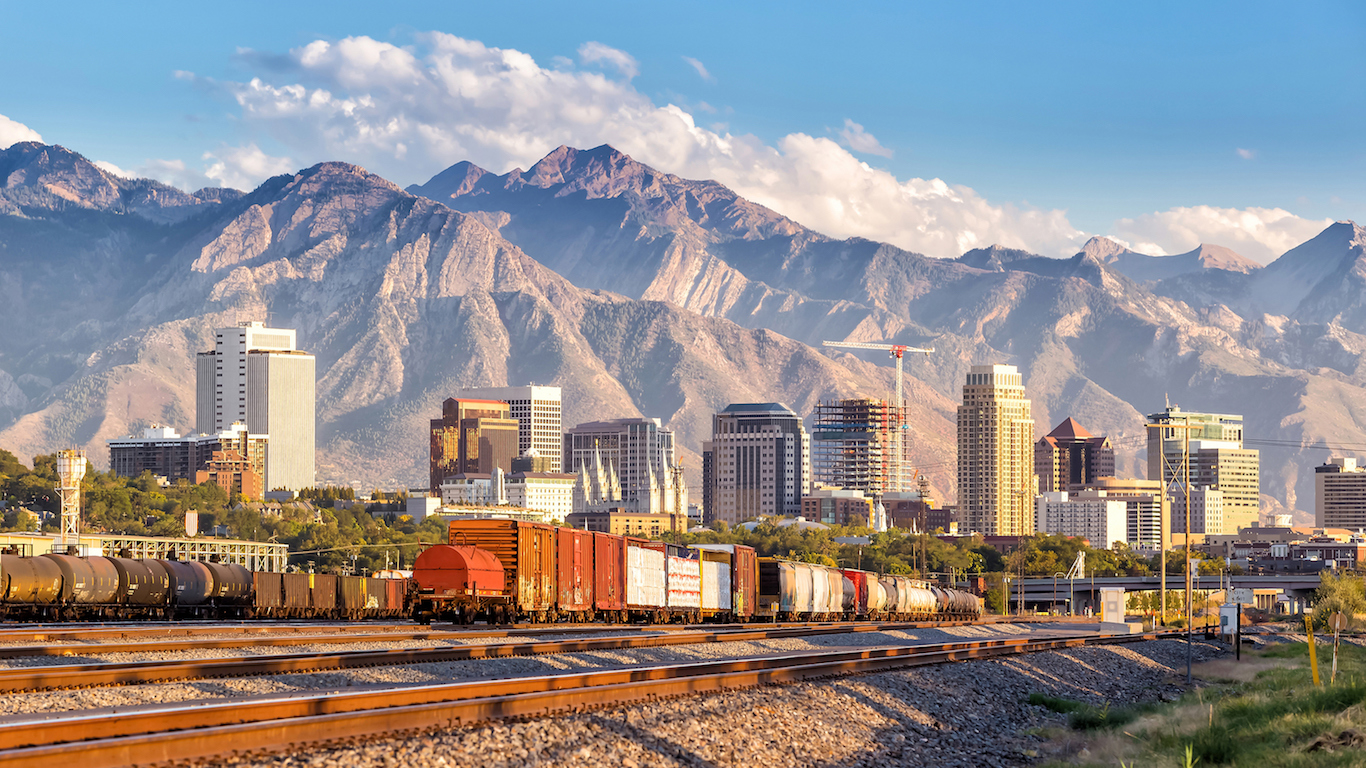
3. Utah
>2016 GDP growth: 3.0%
>2016 GDP: $136.2 billion (19th smallest)
>Largest industry contribution: Information
>1-yr. population change: 2.0% (the largest growth)
Both inbound migration and a relatively high birth rate contributed to Utah’s massive population growth in 2016. The number of residents in Utah rose by 2.0% between 2015 and 2016, the largest increase of all states. Last year, the state’s GDP grew by 3.0%, twice the national rate. Utah’s information services sector was the largest contributor to growth. Much of the state’s information sector is concentrated in the Silicon Slopes region. The region is a cluster of information technology, software development, and hardware manufacturing firms stretching across the Ogden, Salt Lake City, and Provo metro areas. Economic growth was also bolstered by the state’s construction and retail trade sectors.
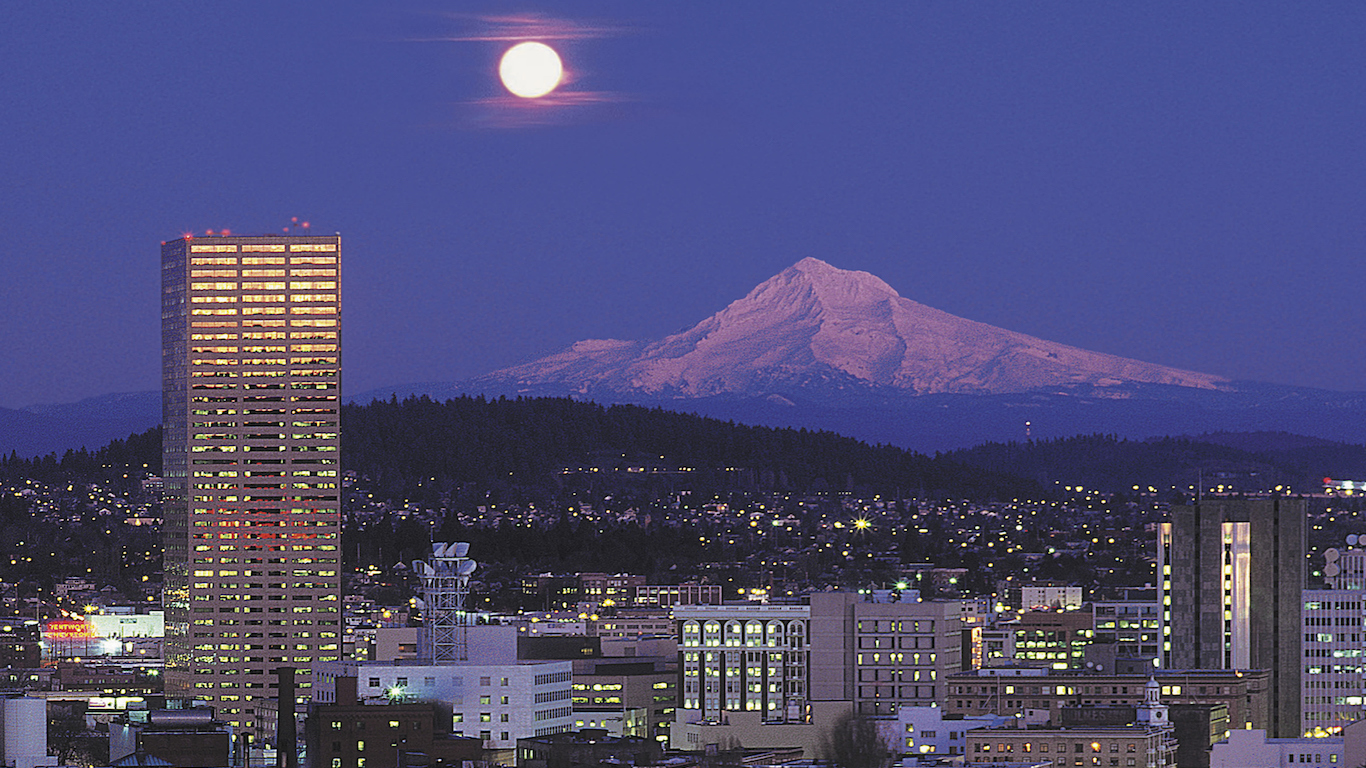
2. Oregon
>2016 GDP growth: 3.3%
>2016 GDP: $207.1 billion (24th largest)
>Largest industry contribution: Durable goods manufacturing
>1-yr. population change: 1.7% (6th largest growth)
Oregon’s GDP grew by 3.3% in 2016, the second most of any U.S. state. The state’s economic expansion was partially attributable to rapid population growth. Largely due to inbound migration, Oregon’s population increased by 1.7% in 2016, the sixth most of any state. The influx of new residents likely contributed to increased activity in Oregon’s real estate and construction industries, which grew more than any other sector in the state other than durable goods manufacturing.
While the national durable goods manufacturing industry remained stagnant over the past year, the sector was the largest contributor to Oregon’s GDP growth. Led by companies such as Intel and Nike, Oregon’s manufacturing sector grew by roughly $2 billion from 2015 to 2016, nearly 30% of the $6.7 billion overall increase in the state’s GDP.
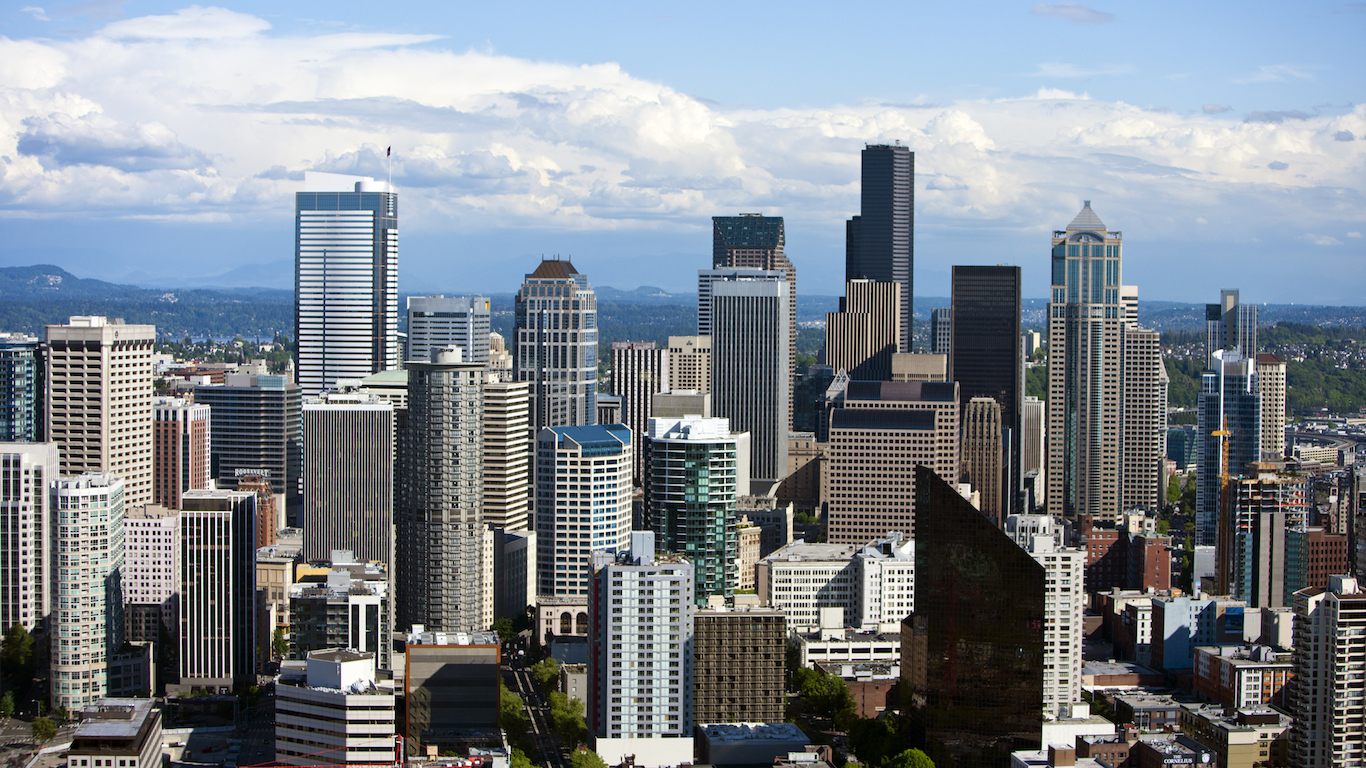
1. Washington
>2016 GDP growth: 3.7%
>2016 GDP: $414.2 billion (14th largest)
>Largest industry contribution: Information
>1-yr. population change: 1.8% (5th largest growth)
Like the U.S. as a whole, Washington’s pace of economic growth has steadily increased over the past several years, from 2.4% in 2013 to 2.9% in 2015. Washington’s economy grew 3.7% from $399.4 billion in 2015 to $414.2 billion in 2016, the largest increase of any state and more than twice the 1.5% national pace. Between 2015 and 2016, the population increased by 1.8%.
Also like the rest of the country, Washington’s information sector contributed the most to economic growth. Led by companies such as Microsoft, Intel, Oracle, and Accenture, the information services sector GDP rose $5 billion in 2016, and today it accounts for 11.4% of the state’s economy as a whole — the largest share nationwide.
Detailed Findings and Methodology:
The decline in mining activity was largely due to the global drop in oil prices. The domestic price of crude oil fell from $95.99 a barrel in 2013 to $38.29 a barrel in 2016 — the lowest price since 2004. The price slump hurt the economies of large oil producing states such as North Dakota, which shifted from the fastest growing economy in 2014 to the fastest shrinking in 2015 and 2016. Mining is the largest sector in each of the four states where GDP shrunk the most in the past year.
Following information services, the largest contributors to the nation’s GDP growth were the professional, scientific, and technical services sector, and the health care and social assistance sector. The aging generation of baby boomers, who continue to require increased medical assistance, helps explain the expanding health care industry. The share of the U.S. population aged 65 and over has risen from 13.1% in 2010 to 14.9% in 2015, making the current population of elderly Americans the largest on record.
Generally, economic growth is driven by two components: population growth and labor productivity. In seven of the 11 states where GDP rose by more than 2.0% in 2016, population growth due to net migration was more than twice the 0.7% national figure.
In states reporting above-average economic growth but not substantial population growth, the rise in GDP was largely due to increased labor productivity. In states such as Hawaii, California, and New Hampshire, where GDP growth outpaced the national rate despite relatively slow population growth, economic expansion led to increases in output per worker. GDP per capita rose faster in New Hampshire, California, and Hawaii than in any other state over the past year.
To determine the states with the fastest growing and fastest shrinking economies, 24/7 Wall St. reviewed 2016 real GDP growth rates for all 50 states based on data from the Bureau of Economic Analysis. The real gross domestic product measurement accounts for the effects of inflation on growth. Real GDP, real GDP per capita, and industry-specific GDP figures also came from the BEA. GDP figures published by the BEA for 2016 are preliminary and subject to annual revision. Real GDP figures for past years have already been revised. Population estimates came from the Current Population Survey, a program jointly sponsored by the U.S. Census Bureau and Bureau of Labor Statistics, and are as of July 1st every year. Age composition data also came from the Census, and data on unemployment and labor force came from the BLS.
If you’re one of the over 4 Million Americans set to retire this year, you may want to pay attention. Many people have worked their whole lives preparing to retire without ever knowing the answer to the most important question: am I ahead, or behind on my goals?
Don’t make the same mistake. It’s an easy question to answer. A quick conversation with a financial advisor can help you unpack your savings, spending, and goals for your money. With Zoe Financial’s free matching tool, you can connect with trusted financial advisors in minutes.
Why wait? Click here to get started today!
Thank you for reading! Have some feedback for us?
Contact the 24/7 Wall St. editorial team.